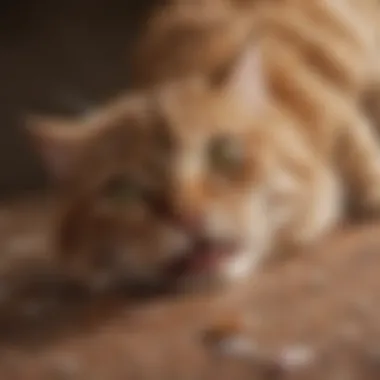Understanding Glue for Cat Nail Caps: A Comprehensive Guide


Intro
When it comes to pet care, one concerns many cat owners have is maintaining their feline's claws. For some, nail caps provide a practical solution. They are small coverings that attach to the cat's nails and serve various functions. However, an essential element of using nail caps correctly is understanding the glue that secures them in place. This article aims to provide a thorough examination of this topic.
Fascinating Facts About Cats
Unique Characteristics
Cats are remarkable creatures. They possess a variety of traits that make them unique among domesticated pets. For instance, they have retractable claws, which protect their claws when not in use. This feature allows them to climb trees with agility and hunt effectively in their natural habitat. Their keen sense of hearing and exceptional night vision further enhance their predatory skills, making them fascinating companions.
Extraordinary Abilities
In addition to their physical attributes, cats exhibit extraordinary abilities that translate into behaviors pet owners often admire. Many cats display impressive agility, able to leap several times their height. They can also balance effortlessly on narrow ledges, showcasing their intricate coordination and body awareness. These abilities underscore the importance of proper claw management, especially when considering the application of nail caps.
Understanding the Glue for Cat Nail Caps
Types of Adhesives Available
When selecting glue for nail caps, it is crucial to choose the right type. There are several adhesive options available. For instance, veterinary-grade adhesives are designed specifically for pet use, ensuring safety and reliability. These adhesives are non-toxic and provide a secure bond without causing harm.
- Cyanoacrylate Adhesives: Commonly known as super glue, these can be quick and effective but must be used with caution.
- Medical Adhesives: Often preferred for their safety and effectiveness, providing a stronger hold suitable for animal use.
Applications
Applying glue for nail caps involves several steps. First, ensure the cat's claws are clean and free from dirt or oil for optimal adhesion. Apply a small amount of glue to the inside of the nail cap before placing it over the nail. It is important not to use excessive amounts of glue, which can cause discomfort.
Safety Considerations
Safety should always be the primary concern when using adhesives with pets. Make sure to use adhesives that are formulated for animal use, as those designed for humans may contain harmful ingredients. Monitor your cat for any signs of irritation post-application. If any concerns arise, consult a veterinarian promptly.
Best Practices for Nail Caps
Regular Monitoring
Once the nail caps are applied, regular checks are necessary. Ensure that the caps remain secure and are not too tight on the nails. Weekly inspections allow owners to address any issues before they escalate.
Alternatives to Nail Caps
If nail caps are not suitable for your pet, consider alternatives. Regular nail trimming is essential. Additionally, soft paws might be an option for those individuals who prefer to avoid gluing altogether.
Remember, the safety and comfort of your feline companion are paramount. Always prioritize their well-being when deciding on methods to manage their claws.
Preface to Cat Nail Caps
Cat nail caps have gained popularity among pet owners who wish to minimize damage caused by their feline friends. These small, plastic covers fit over the cat's claws, providing an effective solution for safeguarding furniture and skin alike. Understanding cat nail caps is crucial for ensuring the well-being of both the pet and its environment.


Purpose and Benefits
The primary purpose of cat nail caps is to protect surfaces and people from the scratches that cats often inflict. This is particularly beneficial for families with young children, elderly individuals, or even pets that may be vulnerable to injury. Some key benefits include:
- Reduced Damage: By covering the sharp tips of cats' claws, nail caps can help preserve furniture, carpets, and walls. This is especially significant for those who rent their living space or have delicate furnishings.
- Enhanced Safety: Nail caps can act as a protective measure against accidental scratches during playtime or when a cat is feeling anxious. They can be comforting for pet owners concerned about the potential risks associated with sharp claws.
- Less Stressful Grooming: For some cats, traditional claw trimming can cause anxiety. Nail caps offer an alternative solution, as well as potentially reducing the frequency of trimming required.
- Style Options: Besides functionality, cat nail caps come in a variety of colors and designs. This can be a fun way for pet owners to express their style preferences while ensuring their cat remains safe.
What Are Cat Nail Caps?
Cat nail caps are small, soft covers that are designed to fit over a cat's claws. Typically made of vinyl or a soft silicone, these caps are non-toxic, allowing for safe use on pets. They are available in multiple sizes, making it essential for owners to select the right fit for their cat.
The process of applying nail caps is relatively straightforward. Most owners opt to use an adhesive to secure the cap onto the claw. This ensures that the cover stays on and functions as intended. It is essential to choose an appropriate adhesive that is also safe for pets.
Using cat nail caps may involve an adjustment period for both the cat and the owner. Initially, a cat may be hesitant to walk or play with the caps on. Nonetheless, with positive reinforcement and patience, many cats adapt to the new additions. This adaptability is a testament to the versatility and utility of cat nail caps as a grooming tool.
Cat nail caps serve as both a practical and stylish option for pet owners striving to maintain a safe environment for their furry companions.
Types of Glue for Nail Caps
Understanding the types of glue for cat nail caps is crucial for ensuring both effectiveness and safety. The right adhesive not only holds the nail caps securely in place but also protects your cat from potential harm. This section will explore three main categories of glue commonly used with nail caps: water-based adhesives, cyanoacrylate adhesives, and non-toxic options. Each type has its own merits and considerations that impact your choice.
Water-Based Adhesives
Water-based adhesives are a popular choice among pet owners for their ease of use and reduced odor. These adhesives tend to be less harsh compared to other types and generally offer a gentler application process for cats. Their formulation makes them easier to clean up, which is advantageous if any spills happen during the application process.
Advantages include:
- Lower toxicity: When using water-based options, the risk of harmful side effects is minimal. This is important because cats are often prone to licking their paws.
- Flexibility in application: They typically work well in diverse environmental conditions and with different materials.
One should also account for disadvantages:
- Longer drying time: Compared to other adhesives, water-based glues may take longer to set. This could be an issue if your cat is wiggling or resisting during application.
Cyanoacrylate Adhesives
Cyanoacrylate adhesives, often referred to as
Application Techniques
Application techniques for cat nail caps are crucial as they greatly influence the effectiveness and longevity of the nail caps. Understanding these techniques ensures that the nail caps are applied correctly, minimizing stress for both the owner and the cat. Proper application can prevent unnecessary problems like falling off or causing discomfort, making this section essential for every cat owner using these products.
Preparing the Cat for Application
Before applying nail caps, it is vital to prepare the cat. Start by choosing a calm environment, free from distractions. It can be helpful to have your cat in a familiar space to reduce their anxiety. Spending some time petting and soothing your cat may create a more relaxed atmosphere.
Some tips to keep in mind during this step include:
- Gather all supplies: Nail caps, glue, nail clippers, and a towel to wrap your cat if needed.
- Familiarize your cat with the supplies: Let your cat sniff the materials so they don't see them as a threat.
- Consider using a comfort item: If your cat has a favorite toy or blanket, keep it nearby.


Using treats to reward your cat can also help create a positive association with the nail caps.
Step-by-Step Application Process
Applying cat nail caps is a straightforward but careful process. Here is a step-by-step guide:
- Trim the nails: Keep the nails short to avoid any discomfort.
- Apply a small amount of glue: Use a non-toxic adhesive designed for nail caps. Avoid over applying the glue, as a small amount is sufficient.
- Insert the cap: Gently place the cap over the nail, ensuring it fits snugly without causing any pressure.
- Hold in place: Keep the cap in position for a few moments to allow the adhesive to set.
- Check for comfort: After application, observe your cat to ensure they are not distressed.
Following these steps reduces the chance of errors during application. It is important to go slowly and remain calm throughout the process.
Ensuring Proper Adhesion
Proper adhesion is essential to ensure that the nail caps stay in place. Here are important considerations:
- Choose the right glue: Use a glue that is specifically formulated for pet use. Some glues can be toxic or cause irritation.
- Avoid moisture: Ensure that nails are dry before application, as moisture can affect adhesion. Consider doing the application in a dry environment.
- Monitor the application: After applying the nail caps, check them daily for signs of peeling or discomfort.
Proper adhesion not only enhances the effectiveness of nail caps but also contributes to the overall well-being of your cat.
Safety Considerations
Understanding the safety considerations when using glue for cat nail caps is crucial. The well-being of your pet is always the priority. It is essential to be aware of what adhesives you are using, as some might contain harmful substances. Knowing the potential risks can help you make informed choices and ensure a safe experience for both you and your cat.
Toxicity of Various Adhesives
Not all adhesives are created equal. Some glues can pose risks if ingested or if they come into contact with your cat's skin. For example, cyanoacrylate adhesives, commonly known as super glue, can bond quickly and effectively but can also be toxic if your cat chews through the nail cap and ingests it. These adhesives can lead to irritation or more severe internal problems. Choosing non-toxic glue alternatives, such as water-based adhesives, is a safer option for pet owners. Always read labels and research ingredients to avoid toxic elements.
Allergic Reactions to Watch For
Cats, like humans, can experience allergic reactions to certain substances. Some glues may contain chemicals that trigger such responses. Skin irritation, redness, or excessive scratching are symptoms to observe closely. If you notice any unusual behavior or physical signs after applying nail caps, it is best to consult with a veterinarian. Keeping track of what products your cat reacts to can help you avoid these in the future. Seeking alternatives like non-toxic or hypoallergenic adhesives can help minimize risks.
Preventing Accidental Ingestion
It is important to take steps to prevent your cat from accidentally ingesting glue or nail caps. First, ensure that the nail caps are properly applied and secure. If a nail cap becomes loose, the temptation to chew on it increases. Supervise your cat after application to monitor their behavior closely. Storing adhesives and other grooming supplies out of reach can also help reduce the risk of accidental ingestion. Education is key; understanding how your cat interacts with its environment can prevent unfortunate incidents.
Proper safety measures when using nail caps can enhance your cat's grooming experience while minimizing any risks associated with adhesives.
Alternatives to Traditional Glue
In the realm of cat nail caps, exploring alternatives to traditional glue can be vital for pet owners. Some may have concerns about the safety or potential for allergic reactions to chemical-based adhesives. Furthermore, alternatives can offer unique benefits in application and usability. Thus, examining these options not only enriches the knowledge of pet owners but also prioritizes the well-being of feline companions.
Double-Sided Tape Options
Double-sided tape presents a compelling alternative to glue for attaching cat nail caps. This type of adhesive is often easier to handle and apply than traditional liquid glues. One main advantage is that it generally has a lower toxicity risk compared to many chemical adhesives. When using double-sided tape, it is crucial to choose a product that is safe for pets. Look for tapes specifically designed for pet use to mitigate adverse reactions.
To apply double-sided tape:


- Cut small pieces of tape that match the size of the nail cap.
- Firmly stick a piece of tape inside the nail cap before placing it on the nail.
- Press the cap onto the nail, ensuring that it adheres well.
- Check periodically to confirm that the cap remains secure.
The removal process of double-sided tape is also uncomplicated. Gently peel away the nail cap without tugging on your cat's nail. Should any residue remain, it can be cleaned with a soft cloth. This method adds convenience, as it bypasses the need for solvents that might be harmful if ingested, keeping your cat safe during the grooming process.
Adhesive-Free Nail Caps
Adhesive-free nail caps are another excellent consideration for those wary of using any type of glue. These caps typically rely on a snug fit to stay in place, reducing the risk of harmful chemicals coming into contact with your cat’s skin. This solution is conducive to cat owners who prioritize minimalistic approaches to pet care.
Various options are available in the market. Many brands are manufacturing adhesive-free nail caps designed with unique shapes and sizes to accommodate different cat breeds. Some of these caps can be a bit more expensive but consider them an investment in the safety and comfort of your pet.
To use adhesive-free nail caps, follow these steps:
- Select the appropriate size for your cat’s nails.
- Gently insert the cap onto the claw, ensuring a tight fit.
- Monitor your cat for a few hours to confirm the caps do not cause discomfort.
Also, these caps can often be reused, making them economical over time. Although there is a risk that they may come off more easily than those with glue, regular monitoring can ensure they remain effective.
Adhesive-free options combine safety with practicality, appealing to many conscientious pet owners.
Considering these alternatives extends beyond mere choice; it reflects a commitment to using safer products that align with the holistic care of your feline companion. Choosing the right option can ultimately improve the grooming experience, ensuring that safety and comfort remain front and center.
Common Questions About Cat Nail Caps
Understanding the various aspects of cat nail caps is essential for ensuring the safety and well-being of your feline friends. As pet owners consider using these products, they often have several questions about their functionality, longevity, and care. Addressing these common inquiries offers clarity and helps in making informed decisions regarding the application of nail caps, all while considering the comfort of the animal.
How Long Do Nail Caps Last?
Nail caps typically last anywhere from four to six weeks. This duration can depend on various factors, such as the activity level of the cat and how well the caps are applied. Generally, less active cats might retain their nail caps longer, as there is less wear and tear through climbing or scratching. Conversely, more active cats or those that groom themselves frequently may experience a shorter lifespan for the caps. It's wise to check the condition of the nail caps regularly and replace them as needed toavoid any potential issues.
Can Nail Caps Be Reused?
Reusing nail caps is not recommended. Once removed, the adhesive may lose its effectiveness, and the caps could also become damaged. Each application creates a secure fit between the cat's nail and the cap. Therefore, using a worn cap can lead to improper adhesion, which may cause it to fall off unexpectedly. For optimal performance and safety, always use fresh caps for each application.
What to Do If a Nail Cap Falls Off?
If a nail cap falls off, it is usually not a cause for serious concern. First, check your cat’s paw for any signs of injury or irritation. If the nail appears healthy, there’s no need to panic. Simply remove the cap from the environment to prevent your cat from accidentally ingesting it. Then, consider reapplying a new nail cap if your cat tolerates it. Make sure to follow proper application techniques to ensure a secure fit again. Regular monitoring is also important; if you notice caps falling off frequently, reevaluate the adhesive being used or the application process.
Keeping a close eye on your cat's nail caps ensures not only their comfort but also their safety.
Culmination
In concluding this article, it is crucial to emphasize the importance of understanding the role of glue in the effective use of cat nail caps. Nail caps serve as a practical solution for managing feline claws, particularly for owners concerned about their furniture or safety in multi-pet households. However, the glue used must be appropriate, safe, and easy to apply.
The key takeaway from the preceding sections revolves around the varous types of adhesives and their specific features. Water-based adhesives are generally less harsh, while cyanoacrylate adhesives provide strong adhesion. Owners should also consider non-toxic options when applying nail caps, ensuring the health and well-being of their pets.
Summary of Key Points
- Choosing the right glue ensures effective adhesion of nail caps.
- Water-based adhesives are easier to handle but may not offer as much durability as stronger options.
- Cyanoacrylate adhesives provide robust attachment but require caution due to potential toxicity.
- Ensuring safety involves monitoring for allergic reactions and preventing ingestion.
- Alternatives, including adhesive-free options, exist for those wary of glue.
Final Thoughts on Nail Caps and Adhesives
Utilizing nail caps can enhance the quality of life for both cats and their owners. The right adhesive can lead to a seamless experience with nail caps, alleviating stress for pet owners. Understanding the properties of different glues, their application techniques, and safety considerations is essential. Pet owners should also not forget the importance of observing their pets post-application. With this knowledge, one can make informed choices that prioritize the safety and comfort of their feline companions.
Always consult a veterinarian if uncertain about the products used on your pet to ensure optimal health and safety.







